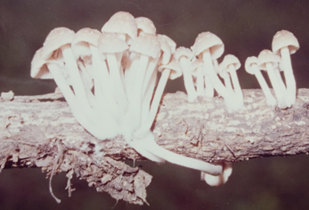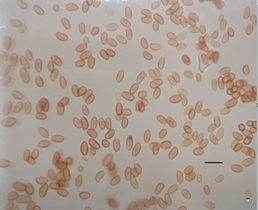Psathyrella magambica Pegler, Kew Bulletin Additional Series 6: 427 (1977) Fig.4
MycoBank number: MB 321251; Index Fungorum number: IF 321251; Facesoffungi number: FoF 10769;
Basionym: Psathyrella magambica Pegler, Kew Bulletin Additional Series 6: 427 (1977)
Pileus 2.0 – 4.0 cm in diameter, fuscous brown, convex-umbonate to broadly campanulate, covered with numerous white loose, fibrillose velar squamules and appendiculate margin. Stipe length 4.0– 6.0cm × 0.2– 0.7 cm in diameter, white to cream, cylindric,equal, hollow, surface covered with minute, fibrillose- floccose squamules. Veil persistent as copius white squamules on pileal surface and stipe. Lamellae adnate, creamish- white later dark fuscous brown, moderately spaced,edge white, pruinose. Spores 5.5 – 7.5 × 3.5 – 4.5µm, ovoid to ellipsoid,slightly bean shaped, truncated by a small germ pore,fuscous brown, moderately thick- walled sometimes with a central germ pore. Basidia 4-spored, clavate. Cheilocystidia abundant , making the lamella edge sterile,ventricose,lageniform, hyaline and thin-walled,.Pleurocystidia abundant,lageniform,hyaline and thin-walled. Add I photo gills clear pic
Ecology and distribution – This species is found to be lignicolous, found in tufts on wood and has a pileus with distinguishable bright squamules.This species has been reported by Pegler (1977) from East Africa, —–
Specimens Examined – JNV/Mycl/ 1028/2018, by Reenu Chouhan, 24°53’18.17″N72°50’52.58″E Sirohi, elevation:321 m (1,053 ft), Mount Abu 72.7083°E 24.5925°N Toad rock area.

a

b
Fig. 4(a) Habit of Psathyrella magambica (b)Spores Scale bar, b= 10 µm
